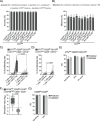Dual Activation-Induced Marker Combinations Efficiently Identify and Discern Antigen-Specific and Bystander-Activated Human CD4+ T Cells
- PMID: 39663678
- PMCID: PMC11830384
- DOI: 10.1002/eji.202451404
Dual Activation-Induced Marker Combinations Efficiently Identify and Discern Antigen-Specific and Bystander-Activated Human CD4+ T Cells
Abstract
Identifying activated T lymphocytes and differentiating antigen-specific from bystander T cells is crucial for understanding adaptive immune responses. This study investigates the efficacy of activation-induced markers (AIMs) in distinguishing these cell populations. We measured the expression of commonly used AIMs (CD25, CD38, CD40L, CD69, CD137, HLA-DR, ICOS, and OX40) in an in vitro T-cell activation system and evaluated their sensitivity, specificity, and positive predictive value. We demonstrated that individual AIMs, while specific in detecting activated CD4+ T cells, poorly discriminate between antigen-specific and bystander activation, as assessed by a discriminative capacity (DC) score we developed. Our analysis revealed that dual AIM combinations significantly enhanced the ability to distinguish antigen-specific from bystander-activated T cells, achieving DC scores above 90%. These combinations also improved positive predictive value and specificity with a modest reduction in sensitivity. The CD25hi/ICOShi combination emerged as the most efficient, with an average sensitivity of 84.35%, specificity of 99.7%, and DC score of 90.12%. Validation through T-cell cloning and antigen re-stimulation confirmed the robustness of our predictions. This study provides a practical framework for researchers to optimize strategies for identifying and isolating antigen-specific human CD4+ T lymphocytes and studying their phenotype, function, and T-cell receptor repertoire.
Keywords: T‐cell clones; activation‐induced markers; antigen‐specific CD4+ T cells; bystander activation; human T cells.
© 2024 The Author(s). European Journal of Immunology published by Wiley‐VCH GmbH.
Conflict of interest statement
The authors declare no conflicts of interest.
Figures



References
MeSH terms
Substances
Grants and funding
LinkOut - more resources
Full Text Sources
Research Materials

